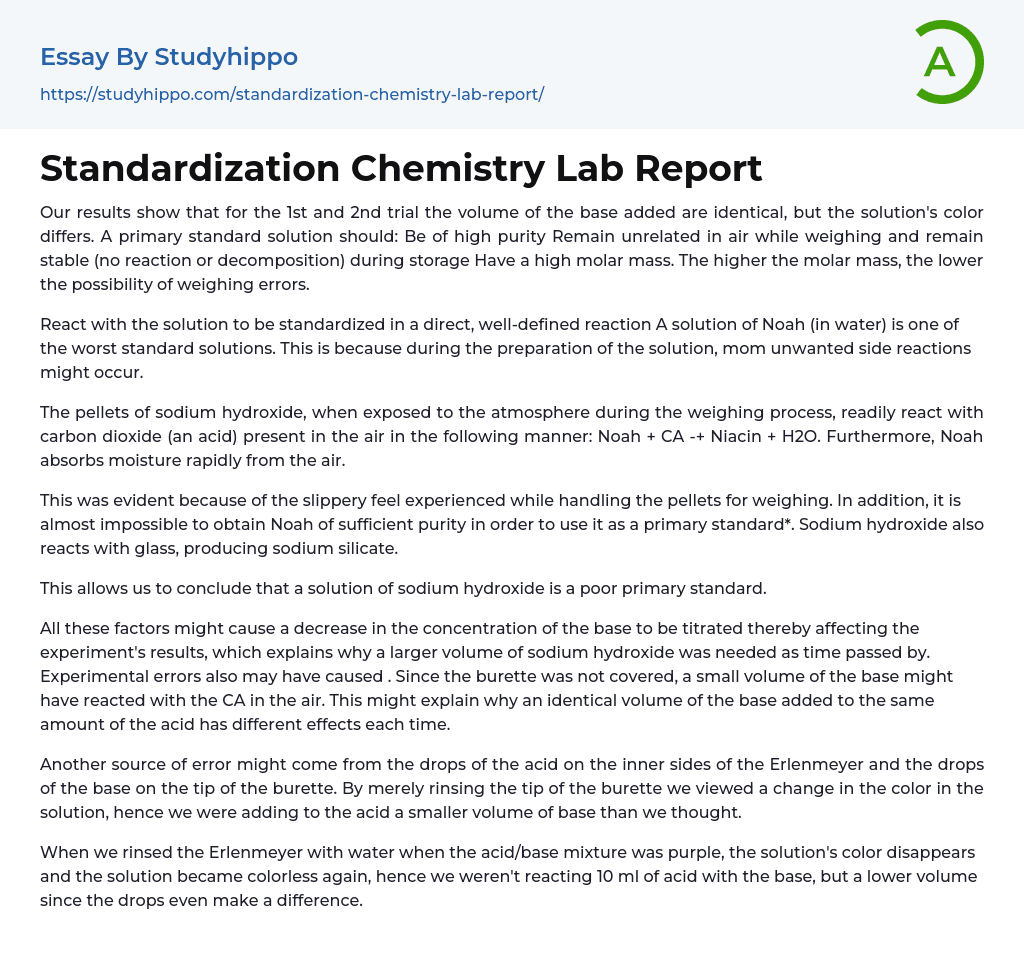Our results show that for the 1st and 2nd trial the volume of the base added are identical, but the solution's color differs. A primary standard solution should: Be of high purity Remain unrelated in air while weighing and remain stable (no reaction or decomposition) during storage Have a high molar mass. The higher the molar mass, the lower the possibility of weighing errors.
React with the solution to be standardized in a direct, well-defined reaction A solution of Noah (in water) is one of the worst standard solutions. This is because during the preparation of the solution, mom unwanted side reactions might occur.
The pellets of sodium hydroxide, when exposed to the atmosphere during the weighing process, readily react with carbon dioxide (an acid) present in the air in the following manner: Noa
...h + CA -+ Niacin + H2O. Furthermore, Noah absorbs moisture rapidly from the air.
This was evident because of the slippery feel experienced while handling the pellets for weighing. In addition, it is almost impossible to obtain Noah of sufficient purity in order to use it as a primary standard*. Sodium hydroxide also reacts with glass, producing sodium silicate.
This allows us to conclude that a solution of sodium hydroxide is a poor primary standard.
All these factors might cause a decrease in the concentration of the base to be titrated thereby affecting the experiment's results, which explains why a larger volume of sodium hydroxide was needed as time passed by. Experimental errors also may have caused . Since the burette was not covered, a small volume of the base might have reacted with the CA in the air. Thi
might explain why an identical volume of the base added to the same amount of the acid has different effects each time.
Another source of error might come from the drops of the acid on the inner sides of the Erlenmeyer and the drops of the base on the tip of the burette. By merely rinsing the tip of the burette we viewed a change in the color in the solution, hence we were adding to the acid a smaller volume of base than we thought.
When we rinsed the Erlenmeyer with water when the acid/base mixture was purple, the solution's color disappears and the solution became colorless again, hence we weren't reacting 10 ml of acid with the base, but a lower volume since the drops even make a difference.
- John Locke essays
- 9/11 essays
- A Good Teacher essays
- A Healthy Diet essays
- A Modest Proposal essays
- A&P essays
- Academic Achievement essays
- Achievement essays
- Achieving goals essays
- Admission essays
- Advantages And Disadvantages Of Internet essays
- Alcoholic drinks essays
- Ammonia essays
- Analytical essays
- Ancient Olympic Games essays
- APA essays
- Arabian Peninsula essays
- Argument essays
- Argumentative essays
- Art essays
- Atlantic Ocean essays
- Auto-ethnography essays
- Autobiography essays
- Ballad essays
- Batman essays
- Binge Eating essays
- Black Power Movement essays
- Blogger essays
- Body Mass Index essays
- Book I Want a Wife essays
- Boycott essays
- Breastfeeding essays
- Bulimia Nervosa essays
- Business essays
- Business Process essays
- Canterbury essays
- Carbonate essays
- Catalina de Erauso essays
- Cause and Effect essays
- Cesar Chavez essays
- Character Analysis essays
- Chemical Compound essays
- Chemical Element essays
- Chemical Substance essays
- Cherokee essays
- Cherry essays
- Childhood Obesity essays
- Chlorine essays
- Classification essays
- Cognitive Science essays




